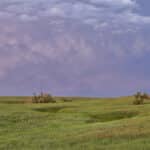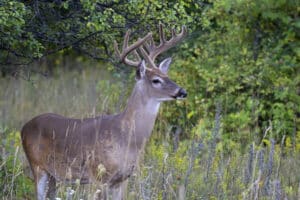When it comes to attracting wildlife to your land, food plots are one of the most effective methods out there. Deer are hungry after all, and a luscious patch of clover or soybeans will ensure that they keep coming back. However, planting an effective food plot goes beyond just throwing some seeds in an unused corner of your land and hoping for the best. By following these simple steps you can ensure a steady supply of bucks and does will visit your land during hunting season.
Placement is Key. In order for a food plot to be successful, you must pick your spot carefully. This starts with the dirt. A common mistake landowners make when selecting a food plot site is choosing a location with sparse vegetation because it will be easier to clear and plant. While these areas might be easier to clear, there’s usually a reason nothing is growing there and a pretty good chance your food plot will fare no better than the native grasses and weeds. Instead, look for a spot on your land where weeds and grass grow readily. Old fields can be a great choice. Open spaces that have been farmed before often contain some quality dirt as well.
It’s also important to consider the area surrounding the food plot. Can deer access the area easily without going out of their way? Is the plot close enough to cover that you can hunt it? Is there a tree or two nearby where you can hide a tree stand? A good food plot location should have you answering “yes” to all of these questions. Also be sure to pick a spot that gets at least four hours of sunshine per day and a good amount of moisture. Stay away from shady areas, sand, rocks and areas that get hit with high winds or scorching temperatures. If native vegetation that aren’t bog plants readily grow there, you’re probably good to go.
Now it’s time to get your soil tested. Dig a few inches down in the soil and take some samples from around the plot. Mix them together in a clean bucket and put some in a plastic bag. Take this sample to your local feed and seed store, or to an agriculture extension office to get analyzed. Within a few days, you’ll get the results and find out if you need to fortify the soil with lime to adjust the pH and discover what kind of fertilizer you should use. A pH of 7 is ideal for most food plot forages, but most will do fine with a pH of more than 6. Below that, the soil will be too acidic and fast-acting lime will need to be added to sweeten things up.
Preparing to Plant. Now that your food plot location has been selected, it’s time to get your hands dirty. You should start by applying an herbicide to the area to kill native plants. It’s a lot easier to chop through dead vegetation to get to good dirt than it is to hack through living plants. A few herbicide applications about a month apart should do the trick. After clearing dead vegetation you’ll need to stir up the dirt and prepare it for planting. For an extremely small plot, a garden rake should be sufficient; plots approaching an acre in size, an ATV pulling an implement is the best way to go.
Choosing Your Forage. Though clover used to be the primary choice for food plots, these days there are a number of companies selling purpose-made food plot mixes. Generally it’s better to stick to these name-brand mixes than to try blending your own. Though clover is still a popular food plot option as a perennial, annuals such as oats and rye are also great choices. So long as you stick with reputable food plot seed companies, you’ll be setting yourself up for success.
Sowing Your Seeds. With your site selected, dirt prepared and seeds picked out, all that’s left to do is plant. Seeds like clover and chicory are vulnerable if buried too deep, so an eighth of an inch is plenty. Also, be mindful of the method you use to spread seed. Your best bet is to use a grass seed spreader, and be sure to follow the seed manufacturer’s recommendations to produce a food plot that will benefit all types of wildlife and greatly increase the deer population on your land.
This content may not be used or reproduced in any manner whatsoever, in part or in whole, without written permission of LANDTHINK. Use of this content without permission is a violation of federal copyright law. The articles, posts, comments, opinions and information provided by LANDTHINK are for informational and research purposes only and DOES NOT substitute or coincide with the advice of an attorney, accountant, real estate broker or any other licensed real estate professional. LANDTHINK strongly advises visitors and readers to seek their own professional guidance and advice related to buying, investing in or selling real estate.










Yeah I can’t believe your recommending spreading herbicide to kill vegetation. Think of all the other good insects and animals you kill. Not to mention that poison will end up in their water. Can’t you recommend something organic that is good for the planet. killing deer is not so bad if you eat the meat but have some consideration of the other wildlife if you plan to have deer around to eat in the future.